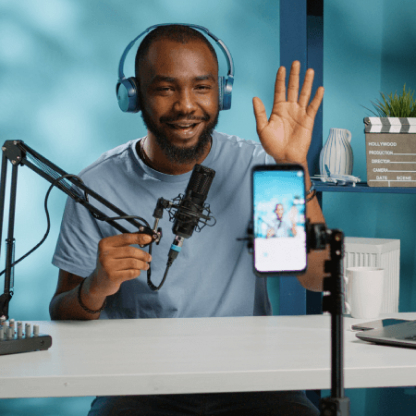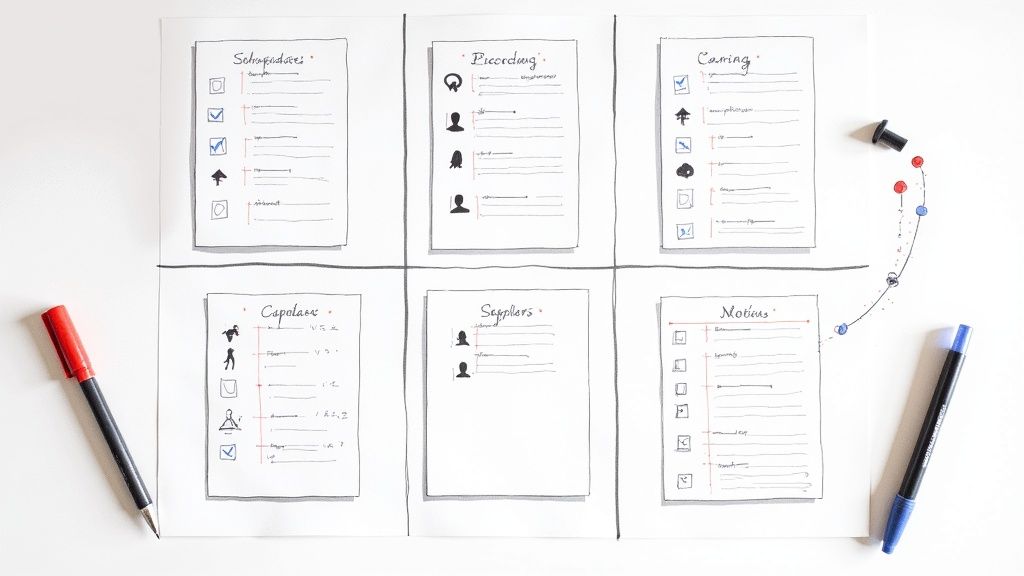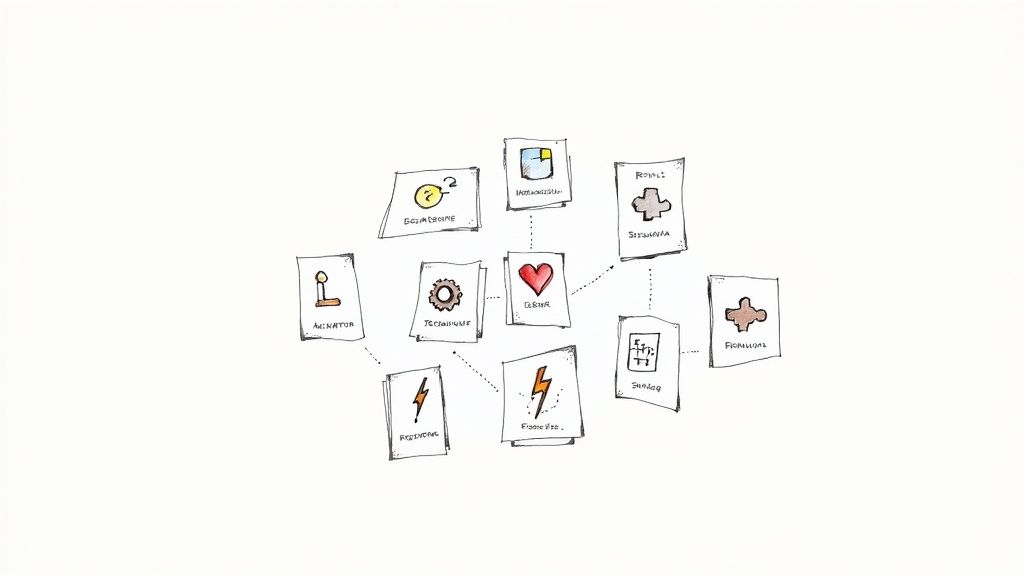Let's be real. The term "pre-recorded video interview" sounds like something cooked up in a corporate lab to make hiring even more robotic. Turns out, it's just a system that lets you clone your best screening questions, send them to candidates, and review their answers whenever you find a spare 15 minutes. No more scheduling nightmares.
So, What Are Pre-Recorded Video Interviews Anyway?
Think of it as a voicemail system for recruiting, but with video—and you can watch it at 2x speed with your morning coffee. Instead of the soul-crushing scheduling back-and-forth across time zones, you get focused, consistent answers from every single applicant. This isn't just another shiny HR tech toy; it's a fundamental shift for founders and hiring managers who'd rather build a company than live in their calendars.
This whole approach is about making smarter, faster decisions without the repetition of first-round phone screens. At its core, a pre-recorded video interview is about capturing candidate responses on their own time. It’s a lot like creating Zoom recordings for presentations, just applied to hiring. To see how this fits into the bigger picture, you can also check out our guide on the broader concept of a digital interview.
To truly get a sense of the shift, let's put the old way side-by-side with the new.
Traditional Phone Screen vs Pre Recorded Video Interview
| Factor | Traditional Phone Screen | Pre Recorded Video Interview |
|---|---|---|
| Scheduling | Requires back-and-forth to find a mutual time, often across time zones. A nightmare. | No scheduling. Candidates respond on their time. You review on yours. |
| Consistency | Interviewer fatigue leads to inconsistent questions and energy levels. It’s human nature. | Every candidate gets the exact same questions, asked in the exact same way. Pure fairness. |
| Efficiency | A 30-minute phone screen takes… wait for it… 30 minutes of real-time effort. | A 5-minute response can be reviewed in under 3 minutes at 2x speed. Do the math. |
| Collaboration | Relies on secondhand notes and biased summaries from one interviewer. | The entire hiring team can review the same video and make a collaborative call. |
| Candidate Experience | Candidates must be available at a specific, often inconvenient, time. | Candidates can prepare and record when they are relaxed and at their best. |
| Scalability | You can only conduct one interview at a time. It’s a bottleneck. | You can screen dozens or even hundreds of candidates simultaneously. It’s a force multiplier. |
One method is a bottleneck; the other is a force multiplier for your hiring. The choice seems pretty clear from here.
The Real-World Impact
The numbers don't lie. Data shows that 47% of companies use video interviews specifically to shorten their time-to-hire. In fact, it shaves an average of 8 days off the hiring timeline compared to phone screens. It’s not just about speed, either. Roughly 74% of recruiters report that this method makes it far easier to shortlist candidates, and 45% say it directly lowers hiring costs.
This isn't just about convenience; it's a strategic move to get ahead.

The image above breaks it down perfectly. When you need to scale your hiring without chaining yourself to your calendar, the pre-recorded format is simply in a league of its own.
The Real-World Benefits and Unspoken Pitfalls

So, is this software actually worth the subscription fee? Let's get right to it. The single biggest win is reclaiming your time. You can screen five, ten, maybe even twenty times the candidates in the hours you used to burn just scheduling and conducting repetitive phone calls.
Suddenly, you’re not just saving a few minutes; you’re fundamentally changing your hiring capacity. This unlocks a wider, more diverse talent pool because you’re no longer limited by who’s free on a Tuesday at 2 PM. Time zones become irrelevant. Your candidate pipeline becomes a 24/7 operation without you needing to be online.
But let's not pretend it's foolproof. Get the execution wrong, and your hiring process feels cold, robotic, and deeply alienating. You risk scaring off fantastic candidates who feel like they're auditioning for a machine instead of talking to a human being.
The Good, The Bad, and The Ugly
Let’s put the abstract pros and cons into real-world terms. Here’s what you’re actually trading when you adopt a pre-recorded video interview platform.
The Upside (The Good):
- Radical Efficiency: You’re not just saving time; you’re multiplying your efforts. Reviewing a five-minute answer at 2x speed takes less than three minutes. Seriously, do the math.
- Built-in Fairness: Every candidate gets the exact same questions delivered in the exact same tone. This structured approach is a powerful antidote to the unconscious bias that creeps into live conversations.
- Deeper Insights, Earlier: You get to see a candidate’s communication style and personality before you ever commit to a 30-minute live call. This front-loads your decision-making with richer data than a resume ever could.
The Downside (The Bad and The Ugly):
- The Impersonal Vibe: If you just send a generic, automated invite, you’re telling top talent they’re just another number. This is the fastest way to lose great candidates before you even meet them.
- The "Performance" Anxiety: Not everyone is a natural on camera. You might accidentally filter out a brilliant engineer who just freezes up under the digital spotlight.
- The Tech Barrier: While most people have smartphones, assuming everyone has a great internet connection and a quiet place to record is a privileged take. You have to provide alternatives.
The bottom line is this: A pre-recorded video interview doesn't fix a broken hiring process. It simply amplifies what’s already there. If your process is thoughtful and human-centric, this tool will make it incredibly efficient. If it’s lazy and impersonal, it’ll make it downright toxic.
This section is the unvarnished truth—the massive upside and the potential downsides—so you can decide if the trade-off makes sense for your stage of growth. Done right, it's a game-changer. Done poorly, it’s a great way to build a company no one wants to work for.
Designing an Interview That Actually Works
Let’s be honest, rolling out a new hiring tool can feel like just one more project on an already full plate. But getting your pre-recorded video interview set up right doesn't have to be a slog. This isn't about adding bureaucracy; it's about making sure the whole thing actually works.
It really boils down to three things: asking questions that get real answers, designing an experience that doesn't feel like a robot interrogation, and using a simple scorecard to keep your own bias in check.
Crafting Questions That Get Real Answers
Your goal isn't to trip people up; it's to get a glimpse into how they think. The problem with generic questions is that they get generic, rehearsed answers. So, it's time to ditch the classic "What are your greatest weaknesses?" and ask something that reveals how someone actually operates.
Here’s a simple framework to get you started:
- Situational Questions: "Describe a time you had to deliver bad news to a client. How did you handle it?" This gives you a window into their real-world communication and empathy.
- Problem-Solving Questions: "Imagine our sign-up conversion rate suddenly dropped by 20%. What are the first three things you would investigate?" This reveals their analytical process, not just a memorized answer.
- Personality & Culture-Fit Questions: "Tell me about a project you worked on that you were genuinely excited about, and why?" This helps you see what truly motivates them beyond a paycheck.
Whatever you do, steer clear of brain teasers. They tell you nothing about a candidate's ability to do the job and only serve to stress them out.
The Candidate Experience Matters Most
How you present the interview is a direct reflection of your company culture. A cold, robotic process suggests a cold, robotic workplace. Is that who you're trying to hire? Didn't think so.
The biggest mistake you can make is forgetting there’s a human on the other side of the screen. Your pre-recorded interview process is their first real taste of what it’s like to work with you. Don't make it a bitter one.
Here’s how to make the experience feel human:
- Record a Welcome Video: Seriously, don't skip this. A short, casual video from the hiring manager or a team member is non-negotiable. It proves a real person is involved and instantly de-escalates candidate anxiety.
- Offer a Fair Chance: Give people reasonable time limits for their answers and, ideally, allow at least one or two opportunities to re-record. Nobody nails a high-pressure presentation on the very first take. A little grace goes a long way.
- Provide Clear Instructions: Don't assume anything is obvious. Clearly explain how the platform works and offer some practical tips on how to record videos. You want them to focus on their answers, not wrestle with the tech. For even more advice, our guide on mastering your on-demand video interview offers pro-level tips for candidates.
Create a Simple Scoring Rubric
The final piece of the puzzle is a simple scorecard. This isn't about being rigid; it's about being consistent. A rubric ensures everyone on your team is evaluating candidates using the same yardstick, which helps you move beyond the "I just got a good feeling" trap.
Simply rate answers on a 1-5 scale across a few key competencies that matter for the role, like "Clarity of Communication," "Problem-Solving Approach," and "Role-Specific Knowledge." This small step is your most effective defense against unconscious bias and makes group decisions incredibly straightforward.
How to Avoid Scaring Away Your Best Candidates
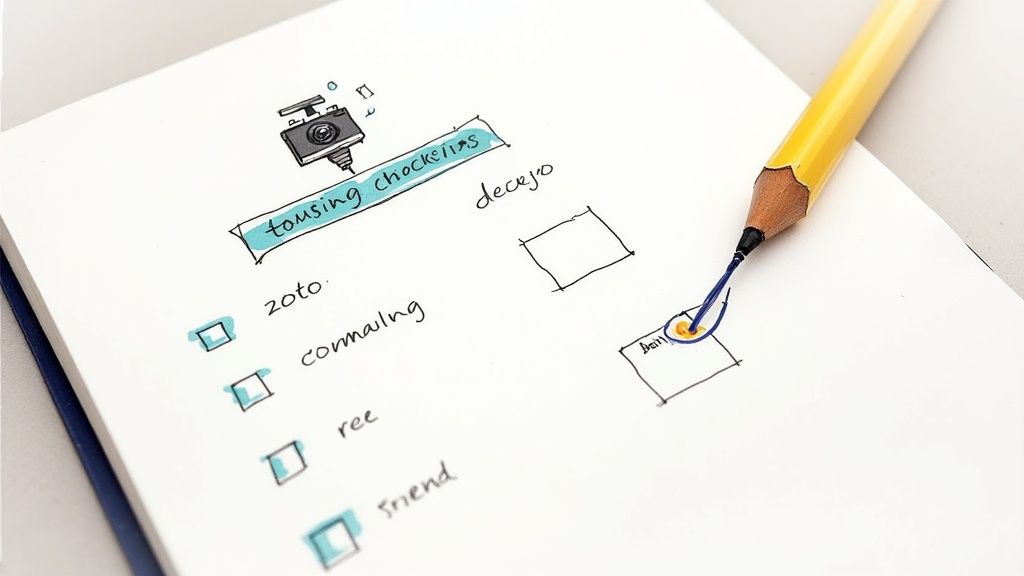
Here’s where most companies completely drop the ball. A pre-recorded video interview can feel as personal as a tax form, but that’s a choice, not a requirement. The secret is injecting your humanity back into the machine before your best candidates click away in disgust.
Let’s be brutally honest: you’re not just evaluating them; they are absolutely evaluating you, your process, and your company culture. A cold, demanding interview process suggests an equally cold and demanding workplace. Is that the signal you want to send?
The Non-Negotiable Welcome Mat
If you do one thing, do this: record a personal welcome video from the actual hiring manager. This isn’t a nice-to-have; it's the bare minimum. It takes five minutes and proves a real, live human is on the other side of the screen, not just an algorithm hungry for keywords.
This simple act transforms the experience from a sterile "audition" into the beginning of a conversation. It sets a human tone and shows you respect their time enough to invest a little of your own. Skip this, and you might as well send an invoice for their application.
Give Them a Fair Shot
Nobody nails a presentation on the first take, especially under pressure. So why would you expect a candidate to deliver a perfect, one-shot performance? It’s a recipe for filtering out brilliant people who just aren’t TV presenters.
A process that feels respectful, not transactional, includes:
- Reasonable Time Limits: Don't give them 30 seconds to explain their life's work. Give them enough time to think and formulate a real answer.
- The Re-Record Button: Allow at least one chance to re-record. This simple feature is a massive stress-reducer and acknowledges that flubs happen.
- Clear Expectations: Be upfront about what you’re looking for. Tell them how long it will take and what kinds of questions to expect.
Your goal is to see how they think, not how well they perform under artificial pressure. Balancing ruthless efficiency with genuine empathy isn't just good karma; it’s good business.
This empathetic approach pays dividends. For younger generations like Gen Z and Millennials, who are used to video communication, this format feels natural and can even reduce interview anxiety when done right. Providing this flexibility and personalization helps foster authenticity and fairness. You can explore more about how a thoughtful approach impacts the candidate experience on Cammio.com.
Alright, you've done it. Your inbox is now a neat little folder packed with candidate videos. But now comes the tricky part.
The single biggest risk with pre-recorded video interviews isn't a technical glitch; it's letting your own brain sabotage the process with unconscious bias. It’s dangerously easy to do. You might find yourself gravitating toward the candidate with the crispest audio, the most impressive bookshelf backdrop, or the smoothest delivery. Before you know it, you’re not hiring for potential, you’re hiring for polish. And that, my friend, is a terrible way to build a great team.
This is exactly why a structured scorecard isn't just bureaucratic fluff. It's your most powerful weapon against your own worst hiring instincts.
Build a Scorecard That Actually Works
Forget complicated, multi-tab spreadsheets. Your scorecard should be brutally simple and tied directly to the demands of the job. If you’re hiring a salesperson, you shouldn't be rating their lighting setup; you should be rating their ability to articulate a value proposition.
Create a simple rubric based on the core competencies for the role. This forces everyone on your team—including you—to evaluate the substance of the answers, not the style of the delivery.
A Dead-Simple Scorecard Template:
- Competency 1: Role-Specific Skill (e.g., "Problem-Solving Approach")
- Rate 1-5: Did they actually outline a logical process?
- Competency 2: Communication Clarity
- Rate 1-5: Could they explain a complex idea without rambling?
- Competency 3: Culture Contribution (e.g., "Collaboration Mindset")
- Rate 1-5: Did their answers reveal a ‘we’ or a ‘me’ attitude?
This isn’t about creating more admin work. It's about building a shared language for what "good" looks like, ensuring you’re having a debate about skill, not just a collection of gut feelings.
The Power of Independent Reviews
Here’s a pro-tip that will absolutely change the game: have multiple reviewers watch and score videos independently before you all sync up. Why is this so critical? Because groupthink is real and it is powerful. The moment one influential person says, "I really liked Sarah," everyone else’s opinion starts to warp, consciously or not.
By forcing independent evaluation first, you get raw, unbiased opinions. You capture everyone’s genuine first impression. When you sync up later, you’re comparing structured data, not just vague feelings and swayed opinions.
This simple discipline makes your debrief meetings faster, smarter, and infinitely more objective. It’s the difference between hiring the person who simply feels right and hiring the person who has proven they have the skills to excel at the job. And that’s a difference that pays dividends for years to come.
Is This the Future of Hiring or Just a Fad?
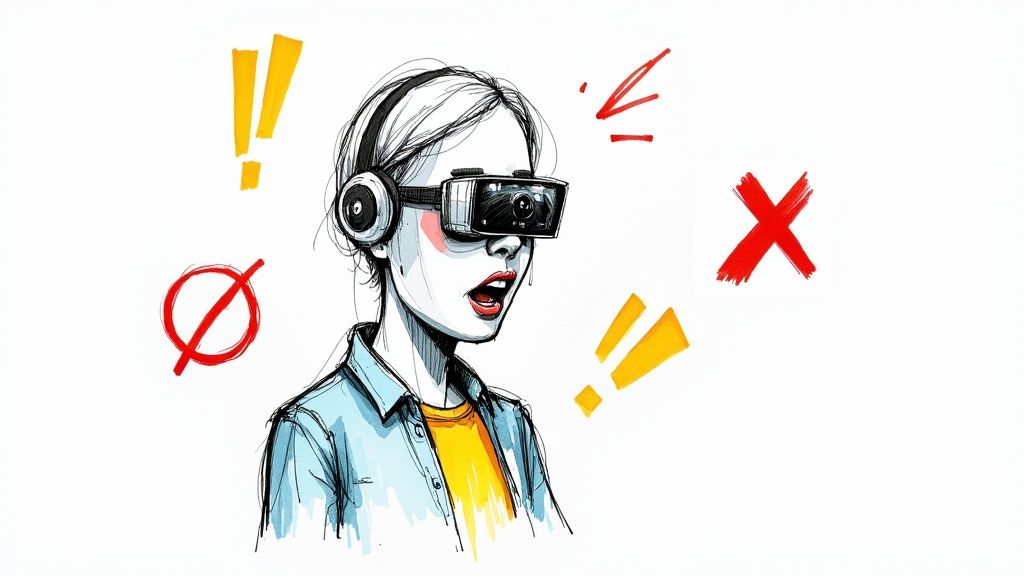
So, let's step back. Is the pre-recorded video interview just a flash in the pan, a temporary fix from our recent remote-work scramble? Or is this something that's truly here to stay? Having seen my fair share of tech fads in recruiting, a little skepticism is healthy. But all signs point to this one having real staying power.
The reason is simple: the very DNA of the workforce is changing. A hiring process that’s flexible and tech-savvy isn’t a nice-to-have anymore—it’s the baseline expectation. Trying to fight this shift is like showing up to a Grand Prix on a bicycle and wondering why you can’t keep up.
The Generational and Remote Work Shift
The data doesn't lie. Millennials now make up over 50% of the American workforce. When you factor in Gen Z, that number is only going up, with their combined employment projected to jump by 25% by 2025. We're talking about a generation of digital natives who practically grew up communicating through video. Forcing them through a rigid, old-school phone screen feels as clunky as sending a fax.
The takeaway here is simple: The future of work is flexible, remote-friendly, and asynchronous. Pre-recorded interviews are practically custom-built for this new reality, designed to help you hire great people across different time zones without the headache of endless scheduling.
And this isn't just about the interview itself. It’s one piece of a much larger movement toward smarter tech across the entire hiring function. Leaders are constantly on the hunt for ways to make their processes sharper and more data-driven, which includes improving human resources with custom-trained AI chatbots and other intelligent tools.
So, is it a fad? Not a chance. This is a foundational block in the modern hiring stack. Ignoring it means you're not just missing out on a tool—you're missing out on the best talent, who have come to expect it.
Frequently Asked Questions
Alright, let's tackle those lingering questions. We've gathered the most common concerns we hear from founders and hiring managers who are still on the fence about pre recorded video interviews. No fluff, just straight answers based on what we’ve seen work (and what we've seen fail spectacularly).
Are Pre Recorded Video Interviews Actually Fair?
They can be—in fact, they're often fairer than a traditional phone screen, but only if you design them thoughtfully. True fairness comes from giving every candidate the exact same set of questions and a consistent evaluation framework. This immediately kills the conversational bias that can derail live chats—you know, the kind where you discover a shared love for fantasy football and accidentally spend ten minutes on it.
The flip side? You have to make it a humane experience. Provide clear instructions, offer reasonable time limits, and give candidates the option for at least one re-take. The biggest mistake is treating it like a high-pressure exam instead of a conversation starter.
What Roles Are These Interviews Good For?
They really shine for high-volume roles or any position where that first screening is all about communication skills, personality, and foundational knowledge. Think sales development reps, customer support agents, or junior marketing roles—anywhere you need to screen dozens of people just to find a handful of gems.
Where are they less effective? For deeply technical positions where the real test is a live coding challenge or an interactive problem-solving session. Use this tool for the top of your funnel, not the final round with your senior architect candidate. For a deeper dive, you can find more advice in our guide with pre-recorded video interview tips.
How Much Does This Software Actually Cost?
The price varies wildly, from "almost free" to "maybe we don't need that office ping-pong table after all." Some Applicant Tracking Systems (ATS) come with a basic version built-in. Standalone platforms can range from a couple hundred bucks a month for a small team to thousands for enterprise plans loaded with all the AI bells and whistles.
But here’s the secret: the real cost isn't the software subscription. It's the hundreds of hours you and your team are currently burning on inefficient, repetitive phone screens. Our advice? Start small, prove the ROI in time saved, and then scale from there.
Ready to stop wasting time on scheduling and start making smarter hires? With Async Interview, you can screen candidates up to ten times faster, collaborate with your team, and find top talent without living in your calendar. Try it free and see the difference for yourself at https://asyncinterview.io.
